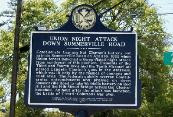According to the scholars of history, the battle of Mu’tah was in the 8th year of Hijrah (629 AD). The background of this battle was that the Prophet Muhammad had sent a letter to the ruler of Busra, but the messenger was intercepted on the way and killed by Al-Ghassani, the Governor of Al-Balqa.
This was considered to be a very serious crime had amounted to declaration of war. Urwah Ibn Zubair said Prophet Muhammad sent this expedition to Mu’tah in in Jumadah Al-Ula in the 6th year of Hijrah and appointed Zaid Ibn Harithah as the commander of the force, and said: ‘If Zaid were slain, then Ja’far Ibn Abi Talib was to take command, and of he were killed then ‘Abdullah Ibn Rawahah’.
Their number was 3,000. They went on their way as far as Ma’an in Syria where they heard that Heraclius had come down to Ma’ab in the Balqa’ with 100,000 Greeks joined by 100,000 men from Lakhm, Judham, Al-Qayn, Bahra and Bali.
The two armies met in or near the village of Mu’tah. After Muslims had arranged themselves in rows, each of the three commanders dismounted his shoes and fought on foot in hand-to-hand combat.
When fighting began Zaid ibn Harithah fought holding the Messenger’s standard, until he died from loss of blood among the spears of the enemy. Then Ja’far took it and fought with it until he was martyred, Abdullah Ibn Rawahah took the standard and fought until he died a martyr.
According to ostensible eyewitnesses, Ja’far received thirty or more wounds on the lower part of his body and exactly seventy-two sword blows and one spear wound on the upper part of his torso.
It was Thabit b. Arqam came forward and grabbed the standard and when he saw Khalid Ibn Walid he ordered him to take hold of the standard. Khalid was elected as the commander and he was able to maintain his heavily outnumbers army of 3,000 men against an army of 10,000 of the Byzantine Empire and Ghassanid Arabs.
Khalid Ibn Walid said: on the day of the battle of Mu’tah nine swords were broken in my hand, and nothing was left in hand except a Yemenite sword of mine.
Twelve Muslim men were martyred on that day. The casualties among the Romans were unknown.
Battle of Mu'tah
This was considered to be a very serious crime had amounted to declaration of war. Urwah Ibn Zubair said Prophet Muhammad sent this expedition to Mu’tah in in Jumadah Al-Ula in the 6th year of Hijrah and appointed Zaid Ibn Harithah as the commander of the force, and said: ‘If Zaid were slain, then Ja’far Ibn Abi Talib was to take command, and of he were killed then ‘Abdullah Ibn Rawahah’.
Their number was 3,000. They went on their way as far as Ma’an in Syria where they heard that Heraclius had come down to Ma’ab in the Balqa’ with 100,000 Greeks joined by 100,000 men from Lakhm, Judham, Al-Qayn, Bahra and Bali.
The two armies met in or near the village of Mu’tah. After Muslims had arranged themselves in rows, each of the three commanders dismounted his shoes and fought on foot in hand-to-hand combat.
When fighting began Zaid ibn Harithah fought holding the Messenger’s standard, until he died from loss of blood among the spears of the enemy. Then Ja’far took it and fought with it until he was martyred, Abdullah Ibn Rawahah took the standard and fought until he died a martyr.
According to ostensible eyewitnesses, Ja’far received thirty or more wounds on the lower part of his body and exactly seventy-two sword blows and one spear wound on the upper part of his torso.
It was Thabit b. Arqam came forward and grabbed the standard and when he saw Khalid Ibn Walid he ordered him to take hold of the standard. Khalid was elected as the commander and he was able to maintain his heavily outnumbers army of 3,000 men against an army of 10,000 of the Byzantine Empire and Ghassanid Arabs.
Khalid Ibn Walid said: on the day of the battle of Mu’tah nine swords were broken in my hand, and nothing was left in hand except a Yemenite sword of mine.
Twelve Muslim men were martyred on that day. The casualties among the Romans were unknown.
Battle of Mu'tah













